In the past weeks, on either side of Bissonnet Street in Houston’s museum district, there’s been a striking contrast in human presence and absence. The joyous Stan VanDerBeek retrospective at the Contemporary Arts Museum Houston, co-curated by Bill Arning and João Ribas, is full of images of people. The Charles LeDray show at the Museum of Fine Arts Houston, workworkworkworkwork, feels more like a ghost town. Or perhaps, a set of spaces still waiting to be inhabited by humans. Both exhibits are awe-inspiring and these two perspectives, even if the artists were born 33 years apart, co-exist comfortably like flip sides of a coin.
VanDerBeek (born 1927) studied at Black Mountain College and hung with Cage and Cunningham, Buckminster Fuller, Yvonne Rainer and Claes Oldenburg, to name only a few of his colleagues and several of my heroes. I see VanDerBeek as a primarily cinematic artist, because even his works on paper and canvas are filled with vibrant motion and seem to be made of light. In the 1950s, he had an intuitive understanding that the world-wide web was on the horizon. Yes, he was way ahead of his time, but I think more importantly that he was completely present in his own time. What a discerning eye for, of all things, eyes. This quality ties him to the Surrealists. It’s as if he was born out of a tear that fell from Buñuel’s Un Chien Andalou (even if the film came out two years after VanDerBeek was born).
To say the exhibit is overwhelming, what is usually gathered under the cliché-rubric of “sensory overload,†is apt. My notes from the opening, scribbled in the midst of friendly conversations, layers of soundtracks and music, videos and films, and wanderings around glass cases and wall displays of notes, photos, collages, drawings and paintings, best reflect my state of mind that night. One page reads, “I am wondering again about experience vs. information and how the presentational methods of an exhibit might actually distance the experience by framing it as information. Look at all the eyes. Repetition of forks. Film-girl with a TV lover, I put a spell on you. Marilyn Wept. Lots of Hollywood icons, Chaplin, drawing on top of photos. Harpo Marx. Find quote from Cocteau about how film could have taken two paths, dream or reality, but sadly took the latter. Montage of different mouths.â€
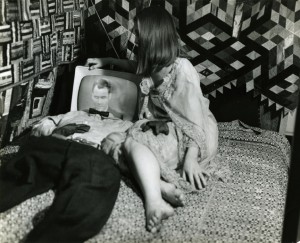
I was instantly attracted to the jokey irony of VanDerBeek’s collages, with their disembodied newspaper and magazine headlines (“God is Alive-And on TV,†or, “A Race Between Education and Catastrophe,†and one of my favorites, “Have You Been Too Busy to Think About Your Life?â€) next to a wide variety of zany baby-boomer imagery. All of it recalls the visual and aural cacophony of my 1960s childhood, and the animation in particular reminds me of Terry Gilliam’s cartoons for Monty Python’s Flying Circus. VanDerBeek asserted his own Dadaist style at least a decade before Gilliam, but the point remains that somehow it captures the joyous artistic spirit that flourished in the 1960s in response to “classic” surrealism, and which moved from exclusive gallery and classroom to mainstream television. VanDerBeek wanted artists to “deal with the world as a work of art,†and believed that, “It is imperative that we quickly find some way for the entire level of world human understanding to rise to a new human scale.â€
I have always loved the artist who takes time to write a manifesto. VanDerBeek imagined “image libraries†as early as 1965 in his “CULTURE: Intercom and Expanded Cinema,†which also references “Movie-Murals,†“Ethos-Cinema,†and something he called “Newsreel of Dreams.†The curators installed one of VanDerBeek’s movie murals in the CAMH gallery, endlessly fascinating, I found myself almost unable to walk away from it:
It was a hot Houston Sunday afternoon when I returned to the cool splendor of an interior, windowless gallery in the Museum of Fine Arts to look once again at the stunning installation Charles LeDray’s sculptures, workworkworkworkwork. I had to look up and squint somewhat to see the details of his 1993 Village People, a mixed media piece about five inches high, 18 feet long and four inches deep. It’s a series of small hats hanging off the wall, nine feet above the floor, which seems a way of ensuring that viewers won’t quite see the precise details of each one, for example, the extraordinary hand-stitching or the carefully painted slogans like “World’s Best Dad.†It isn’t the first piece that makes me feel slightly out of place. Throughout the exhibit, LeDray frequently creates a situation whereby the adult viewer might feel more like a child or, if one is actually a child, he or she might feel invited into the sculpture, in solidarity with the scale of it.
In a transcribed conversation with curator Claudia Gould in 2002  (see the catalog from Institute of Contemporary Art, University of Pennsylvania, Philadelphia), LeDray said, “…I was working as a guard at the Seattle Art Museum. There, I saw plenty of contemporary art, but also many other wonderful things.†Most everything I’ve read about the mysterious LeDray recalls this anecdote: that he was struggling as a lowly museum guard, inspired by the objects around him, and largely self-taught. There seems a kind of bourgeois condescension in the fascination with this story, as if his job as a guard was something he’d “overcome” only to emerge as a highly sought-after artist. “You can do it if you work hard enough,” that kind of thing. Americans love these Horatio Alger myths. I can’t get the idea out of my head, though, because a museum guard pacing nearby is not only watching me like a hawk, she’s also talking loudly on her mobile phone. “So, don’t hate on her,†the guard says loudly to her confidante, “feel sorry for her!â€Â My first response is irritation, and I  try to embarrass the guard into hanging up through what I think is a clever assertion of stiff body language and piercing glares. She continues the conversation, regardless, so I give up and move to another part of the gallery.
But not until I copy down the placard in front of this particular piece, which reminds the viewer that Village People was also a 1970s disco band, along with a curator’s interpretation, “LeDray’s purpose is more generous, suggesting the many lifestyles and cultures that can be gathered together in a given community.†To me, this sounds like poorly written persuasive text for some unrealized city-planning project,  or perhaps a failed grant application. The individual hats, as on my first visit to the gallery, for me evoke a more personal and highly emotional response. One has dreadlocks lining the inside of the brim, another is a triangle of swiss cheese, one says “Senior Power,” some look as if they go with a certain kind of uniform. They remind me of all the men I have ever known: the milkman who in the 1960s often gave me a ride to the school-bus stop, a neighbor who had suddenly discovered Karate, some scary but intriguing boy on a motorcyle, that stoner in Burlington who occasionally slept with a guy, etc. Sometimes I have a dream where all of my ex-lovers are in the same room together. Seeing LeDray’s Village People is like extending that experience  to include all one’s male relatives, authority figures, schoolmates and acquaintances.
While I’m making notes, another Security Guard comes up to me and says, “are you doing homework?†Because I am in a gallery, I have a more philosophical feeling about her question, but I laugh and say “no” anyway. What is it with the guards in the MFA? Across the street, they are friendly but professionally distant. And over here, it doesn’t seem like any of them are potential highly sought-after sculptors, but it makes me notice the absence of people in LeDray’s work. Or rather, the representation of people. In many ways, the entire thing is about the footprints left by people. There are hundreds of small hand-made pieces of clothing, some of it purposely cut out to sort of invigorate the garment with negative space:
And finally, a third Security Guard tells me, “not to point at object,” which makes me want to point at it just to prove that my action is hardly a crime. I wonder to myself briefly if LeDray acted like such a fascist when he was a guard in Seattle.
I retreat into another installation, a darkened room with a store window and dimly backlit.  There are jewelry stands (all of them hand-made by LeDray) but without any jewelry displayed on them. Suddenly, I am transported back to Pearl Street in Hartford, where I remember routinely walking by a store in the night and looking at all of the stands without their jewelry. I feel a sudden shiver, as if my mind has melded with that of the artist. It is indescribable, really. And the thought leads me towards Wallace Stevens, in particular a passage from The Man With the Blue Guitar:Â
Things as they are have been destroyed.
Have I? Am I a man that is dead
At a table on which the food is cold?
Is my thought a memory, not alive?



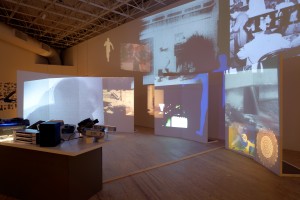
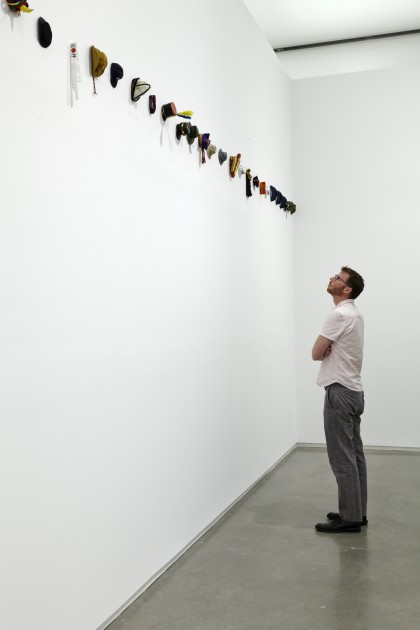
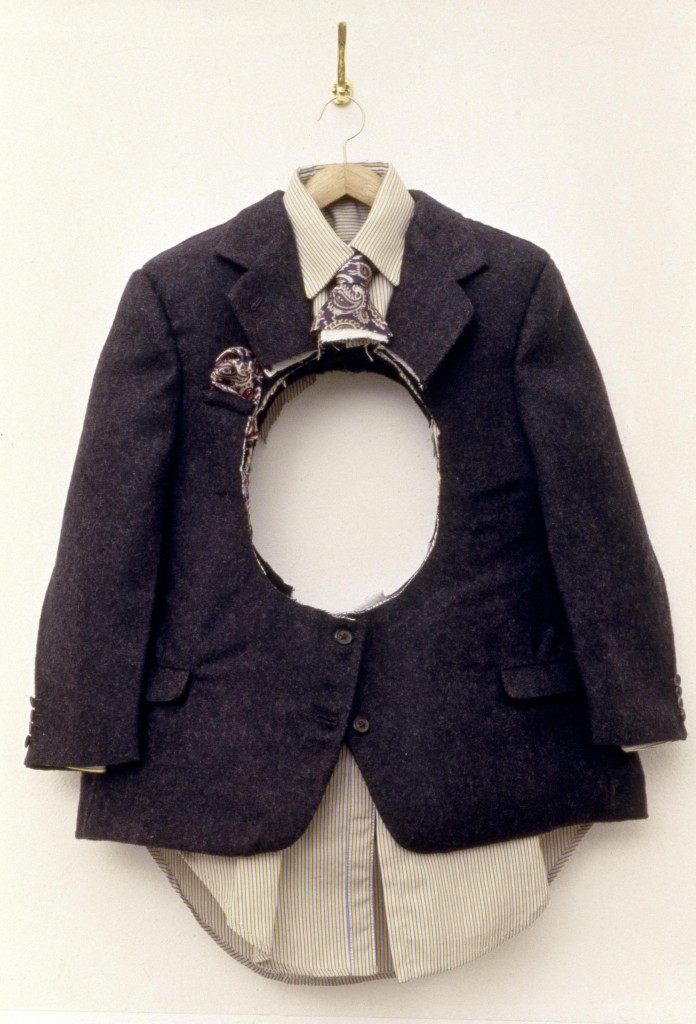
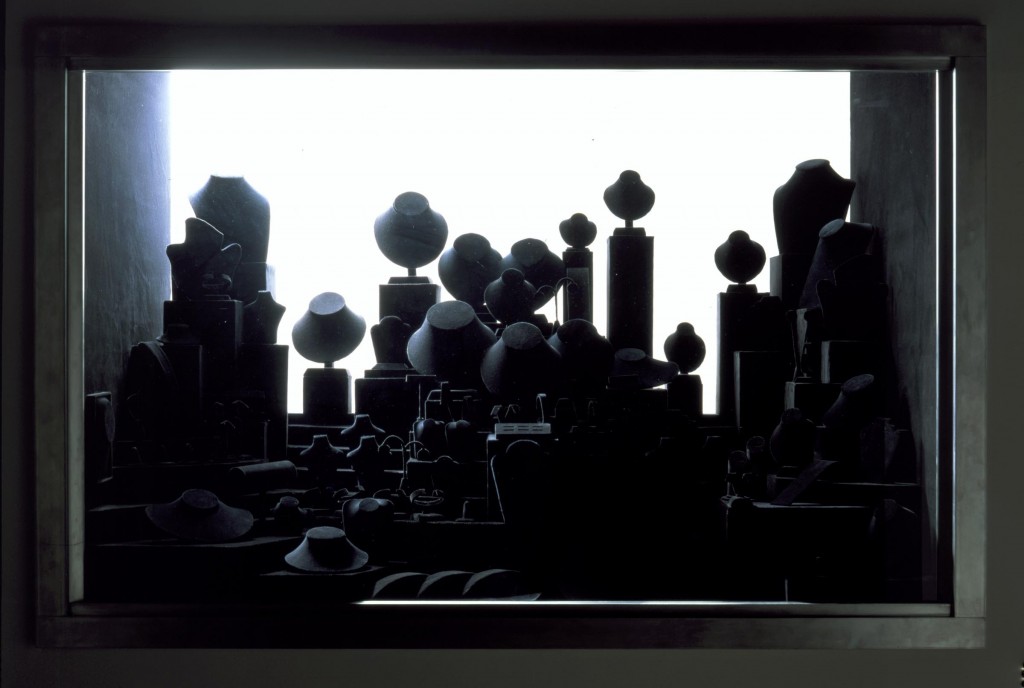
Really, three odd interactions with guards at the same exhibit? The exhibit about work from an artist who was a former museum guard? You don’t find that at least a little suspicious? My gut instinct is to wonder if these guards who are ‘busy’ working are part of the exhibit itself. Perhaps too much of a meta view. The only time a museum guard ever initiated a contact with me in a museum though, was when I took a picture of something I shouldn’t. At, of course, the Seattle Art Museum.
Ha! I like this very much. Why didn’t it occur to me? Of course! They were splendid, really! Thanks so much for writing,
tedd
I saw this exhibition at the MFAH three times, two of them with my hyper-aware fidgety four-year-old daughter. Anyone out there with a feisty little four-year-old of their own?
For those who don’t know much about this exhibit, there are, among other things, a pair of enormous glass vitrines, something like 7 feet tall and 3 feet square, with about six shelves in each vitrine, with each shelf covered with dozens or hundreds of miniature ceramic pots. On the back of my envelope I calculate something like 5,000 pieces total, but there might be any number from 1,000 to 10,000. (Unless someone out there has a better figure, I have half a mind to pop back in, and make a better estimate).
Different guards react to my daughter differently. And this is consistent across the museum, not just in the LeDray exhibit. Older male guards get the most upset when they see her. Older females get the most visibly joyful. Younger males are mostly non-plussed, if suspicious. Mommy-aged females are happy to see her. I’m not sure about the younger females. Judging from the blog post above, they are too busy chatting to their friends on their phones. Anyway, this trend also appears to hold true in other exhibits, like the Turrell Tunnel, so I don’t think we can say the guards’ act is “part of the art” in the LeDray exhibit.
On my daughter’s second visit to this exhibit — forgive me if I try to block most of the memory of her first visit — the guard closest to the pair of vitrines was an older lady, of older-mommy or younger-grandma age. When she saw my daughter — whom I was holding in my arms, so as not to make a crazy situation crazier — she was so happy to help her look for the pots she liked. Of course she liked the ones with flowers on them (or shaped like them). At some point it almost seemed like the guard told herself, “whoops, this is not my grand-daughter, I’d better get back to work!,” and promptly did so.
I didn’t know LeDray was a museum guard. This is extremely interesting to me, and even moreso since his works are so difficult to guard. The fabric pieces are delicate and exposed to the elements, and the tiny ceramic pieces are piled high in a pair of huge glass vitrines. I’m not sure we should read too much into this, but it does seem interesting to me, and I wonder if he has any thoughts about the idea of guarding his pieces.